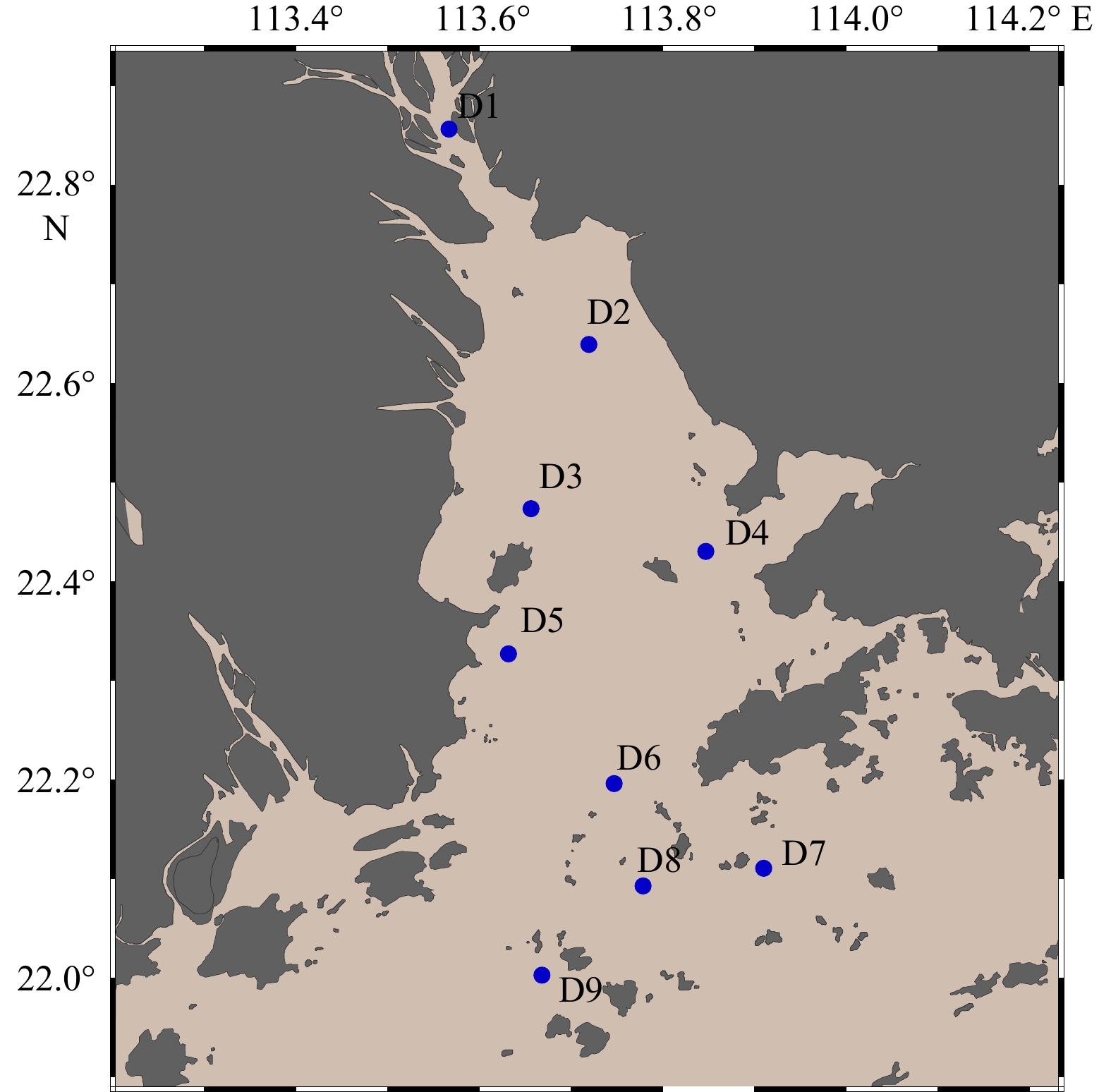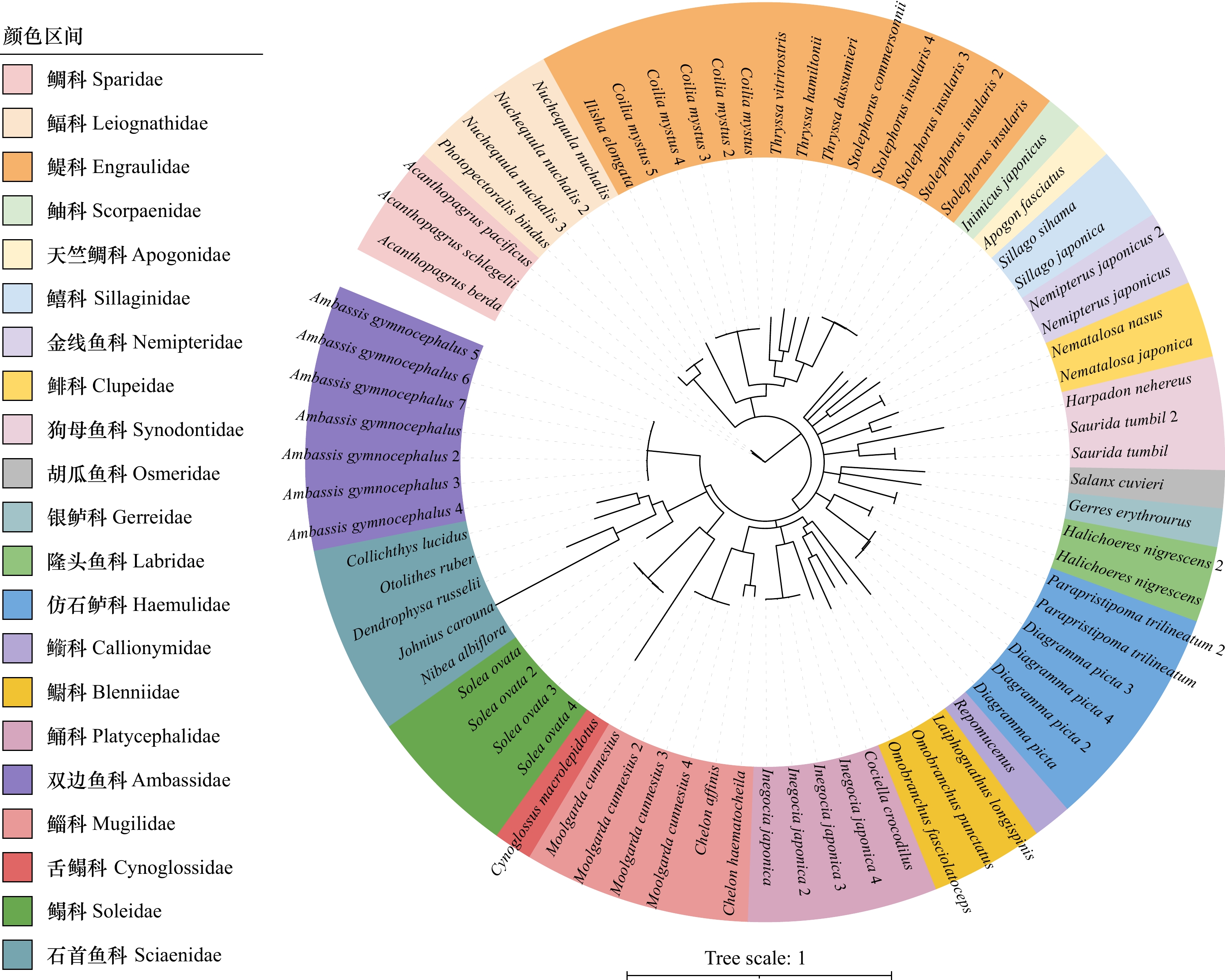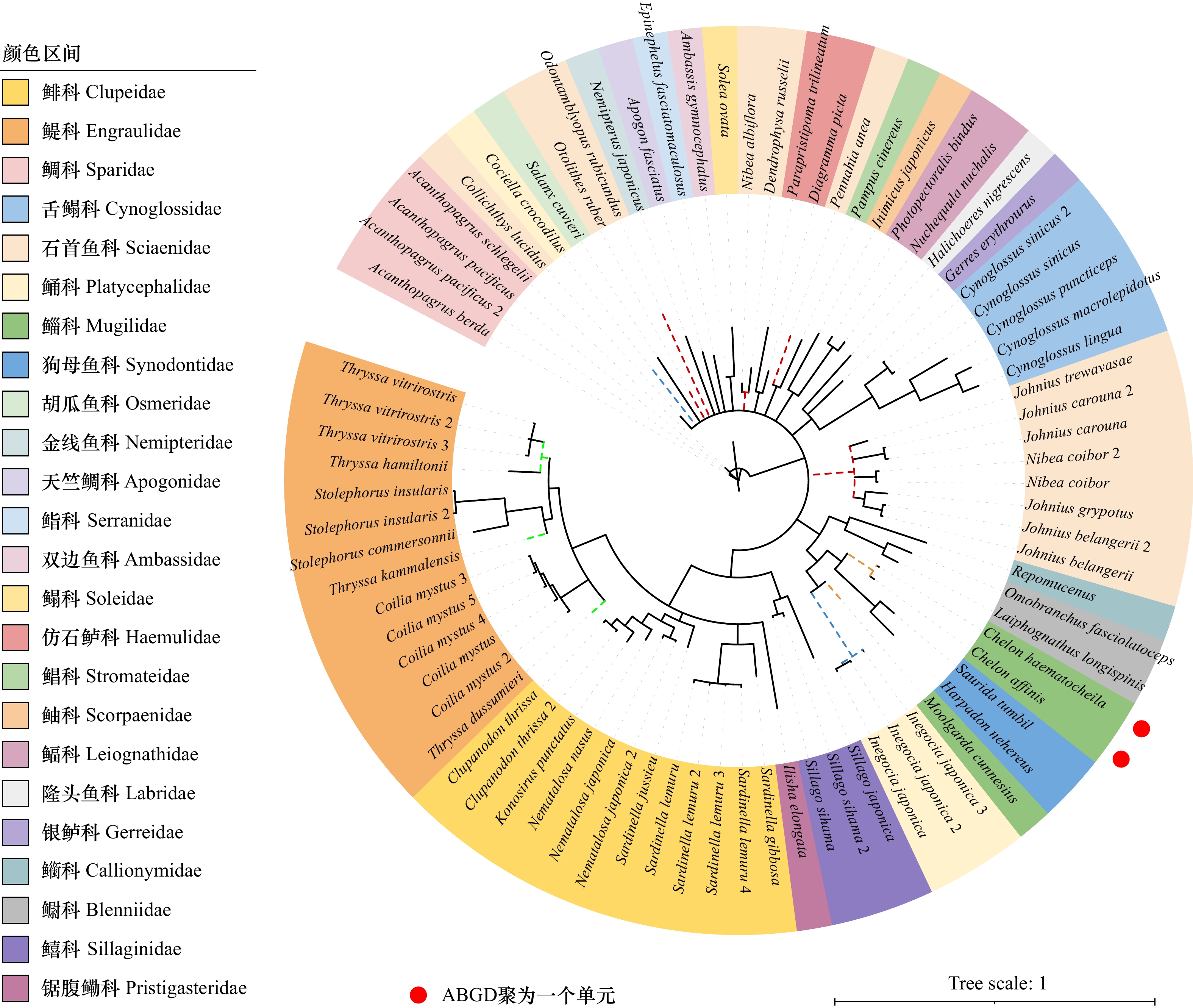Species composition and distribution characteristic of fish eggs and larvae based on DNA barcoding technology of the Zhujiang River Estuary in spring
-
摘要: 采用线粒体COⅠ和12S rRNA基因片段作为DNA条形码,分析珠江口春季鱼卵和仔稚鱼种类组成和分布特征,并探究两种条形码在鱼卵和仔稚鱼种类鉴定中的适用性。研究共扩增样本391个,成功鉴定的鱼卵和仔稚鱼共7目25科42属60种(2种未鉴定到种)。其中,以鲈形目(Perciformes)种类和数量最多,种类数占比为51.6%,数量占比为47.91%;其次为鲱形目(Clupeiformes),种类数占比为25%,数量占比为34.56%。优势种10种,其中凤鲚(Coilia mystus)优势度最高,为0.071;棘头梅童鱼(Collichthys lucidus)最低,为0.014。COⅠ和12S rRNA基因片段扩增结果显示,鱼卵和仔稚鱼12S rRNA基因片段扩增成功率(95.60%)明显高于COⅠ基因(43.22%)。遗传距离和ABGD分析显示,COⅠ基因种内遗传距离为0~0.005(平均0.003),种间遗传距离为0.061~0.376(平均0.253),两者间存在明显的“条形码间隙”,ABGD划分结果与数据库比对结果一致;12S rRNA基因种内遗传距离为0~0.011(平均0.007),种间遗传距离为0.007~0.487(平均0.283),龟鰉(Chelon haematocheila)和前鳞龟鰉(Chelon affinis)种间遗传距离与种内遗传距离不形成“条形码间隙”,ABGD将其划分为同一种。系统发育分析显示,在种的分类阶元,所有物种均能聚为独立分支,得到有效区分。综上,线粒体COⅠ和12S rRNA条形码可有效鉴定珠江口大多数鱼卵和仔稚鱼,但是COⅠ基因扩增成功率较低,12S rRNA基因部分近缘物种存在区分困难的情况,两种基因结合使用更能提高鱼卵和仔稚鱼种类鉴定的成功率和准确性。
-
关键词:
- COⅠ基因 /
- 12S rRNA基因 /
- 鱼卵和仔稚鱼 /
- DNA条形码
Abstract: In order to improve the success rate and accuracy of species identification of fish eggs and larvae, fish eggs and larvae samples collected from the Zhujiang River Estuary in spring were identified by DNA barcoding technology based on the mitochondrial COⅠand 12S rRNA genes. A total of 391 samples were amplified and 60 species in 7 orders, 25 families, 42 genera were successfully identified (2 species were not identified). Among them, Perciformes had the most species and quantity accounting for 51.6% and 47.91% respectively, followed by Clupeiformes with 25% and 34.56% respectively. There were 10 dominant species, among which Coilia mystus had the highest dominance of 0.071, Collichthys lucidus had the lowest dominance of 0.014. The amplification results of COⅠand 12S rRNA gene fragments showed that the success rate of 12S rRNA gene amplification in eggs and larvae (95.60%) was significantly higher than that of COⅠgene (43.22%). Genetic distance and ABGD analysis showed that the intraspecies genetic distance of COⅠ gene was 0−0.005 (average was 0.003), and the interspecific genetic distance was 0.061−0.376 (average was 0.253), and there was an obvious “barcode gap” between them. The intraspecific genetic distance of 12S rRNA gene was 0−0.011 (average was 0.007), and the interspecific genetic distance was 0.007−0.487(average was 0.283). which do not form a “barcode gap” between the interspecific and intraspecies genetic distances. The Bayesian phylogenetic tree based on COⅠ and 12S rRNA genes showed that all species could be clustered into independent branches and can be effectively distinguished. The above results show that both COⅠ gene and 12S rRNA gene can be used for the identification of most fish eggs and larvae, but the success rate of COⅠ gene amplification is low, and it is difficult to distinguish some closely related species of 12S rRNA gene. The combined use of the two genes can improve the success rate and accuracy of species identification of fish eggs and larvae.-
Key words:
- COⅠgene /
- 12S rRNA gene /
- fish eggs and larvae /
- DNA barcoding
-
表 1 具体采样时间和站位
Tab. 1 Specific sampling time and stations
站位 采样时间 水深/m 表层盐度 D1 2020年4月3日 24 1.45 D2 2020年4月3日 15 7.85 D3 2020年4月2日 6 6.95 D4 2020年4月2日 10 25.6 D5 2020年4月1日 6.5 8 D6 2020年4月1日 9 23.57 D7 2020年4月1日 24 32.52 D8 2020年3月31日 13 28.82 D9 2020年3月31日 18 27.82 表 2 不同站位鱼卵及仔稚鱼种类和数量
Tab. 2 Species and quantity of eggs and larvae at different stations
站位 总扩增数 有效数 种类数 鱼卵 仔稚鱼 鱼卵 仔稚鱼 鱼卵 仔稚鱼 D1 42 4 42 4 5 3 D2 39 0 38 0 9 0 D3 31 17 28 17 14 7 D4 40 0 40 0 15 0 D5 40 8 40 8 14 4 D6 40 1 40 1 20 1 D7 42 0 42 0 18 0 D8 40 5 36 5 18 3 D9 38 4 37 4 10 4 总计 352 39 343 39 52 15 表 3 珠江口春季鱼卵及仔稚鱼种类组成和数量分布
Tab. 3 Species composition and quantity distribution of fish eggs and larvae in Zhujiang River Estuary in spring
目 科 属 种 样本量/个 相似度/% 站位 12S rRNA COⅠ D1 D2 D3 D4 D5 D6 D7 D8 D9 鲱形目
Clupeiformes锯腹鳓科
Pristigasteridae鳓属
Ilisha鳓鱼
Ilisha elongata1 100 99.85 ─ ─ ─ ─ ─ ─ ─ ○ ─ 鳀科
Engraulidae棱鳀属
Thryssa黄吻棱鳀
Thryssa vitrirostris6 100 99.82 ○ ─ ─ ○ ─ ○ ─ ○ ─ 赤鼻棱鳀
Thryssa kammalensis6 100 ─ ─ ─ ─ ─ ─ ○ ◎ ─ ─ 杜氏棱鳀
Thryssa dussumieri4 100 99.85 ─ ─ ─ ─ ○ ○ ○ ─ ─ 汉氏棱鳀
Thryssa hamiltonii1 100 100 ─ ─ ─ ○ ─ ─ ─ ─ ─ 侧带小公鱼属
Stolephorus岛屿侧带小公鱼
Stolephorus insularis20 100 100 ─ ─ ○ ─ ○ ○ ◎ ◎ ─ 康氏侧带小公鱼
Stolephorus commersonnii1 100 99.40 ─ ─ ─ ○ ─ ─ ─ ─ ─ 鲚属
Coilia凤鲚
Coilia mystus61 100 100 ● ○ ◎ ─ ◎ ─ ─ ─ ─ 鲱科
Clupeidae小沙丁鱼属
Sardinella黄泽小沙丁鱼
Sardinella lemuru17 100 ─ ─ ─ ◎ ◎ ○ ○ ─ ○ ─ 隆背小沙丁鱼
Sardinella gibbosa4 100 ─ ─ ─ ─ ─ ─ ─ ○ ─ ─ 裘氏小沙丁鱼
Sardinella jussieu2 100 ─ ─ ─ ○ ─ ─ ─ ─ ─ ○ 斑鰶属
Konosirus斑鰶
Konosirus punctatus1 99 ─ ─ ─ ─ ─ ─ ○ ─ ─ ─ 海鰶属
Nematalosa日本海鰶
Nematalosa japonica2 100 100 ─ ─ ─ ─ ─ ─ ○ ─ ─ 高鼻海鰶
Nematalosa nasus1 100 100 ─ ─ ─ ○ ─ ─ ─ ─ ─ 鰶属
Clupanodon花鰶
Clupanodon thrissa5 100 ─ ○ ─ ○ ─ ─ ─ ─ ─ ─ 胡瓜鱼目
Osmeriformes胡瓜鱼科
Osmeridae银鱼属
Salanx居氏银鱼
Salanx cuvieri1 99 99.69 ○ ─ ─ ─ ─ ─ ─ ─ ─ 仙女鱼目
Aulopiformes狗母鱼科
Synodontidae蛇鲻属
Saurida多齿蛇鲻
Saurida tumbil2 100 99.84 ─ ─ ─ ─ ─ ○ ○ ─ ─ 龙头鱼属
Harpadon龙头鱼
Harpadon nehereus1 100 100 ─ ─ ─ ─ ─ ─ ○ ─ ─ 鲻形目
Mugiliformes鲻科
Mugilidae莫鲻属
Moolgarda长鳍莫鲻
Moolgarda cunnesius6 100 100 ─ ─ ○ ─ ─ ○ ─ ○ ○ 龟鰉属
Chelon龟鰉
Chelon haematocheila9 100 100 ○ ◎ ─ ─ ─ ─ ─ ─ ─ 前鳞龟鰉
Chelon affinis1 100 100 ─ ─ ─ ─ ─ ─ ─ ─ ○ 鲉形目Scorpaeniformes 鲉科
Scorpaenidae鬼鲉属
Inimicus日本鬼鲉
Inimicus japonicus1 100 99.84 ─ ─ ─ ○ ─ ─ ─ ─ ─ 鲬科
Platycephalidae鳄鲬属
Cociella鳄鲬
Cociella crocodilus2 100 100 ─ ─ ─ ─ ○ ─ ─ ○ ─ 瞳鲬属
Inegocia日本瞳鲬
Inegocia japonica9 100 100 ─ ─ ○ ─ ─ ─ ◎ ─ ─ 鲈形目
Perciformes双边鱼科
Ambassidae双边鱼属
Ambassis裸头双边鱼
Ambassis gymnocephalus11 100 100 ○ ○ ─ ◎ ─ ─ ─ ─ ─ 鮨科
Serranidae石斑鱼属
Epinephelus斑带石斑鱼
Epinephelus fasciatomaculosus3 100 ─ ─ ─ ─ ─ ─ ○ ─ ○ ─ 天竺鲷科
Apogonidae天竺鲷属
Apogon宽条天竺鲷
Apogon fasciatus1 100 100 ─ ─ ─ ─ ─ ─ ─ ○ ─ 鱚科
Sillaginidae鱚属
Sillago多鳞鱚
Sillago sihama5 100 100 ─ ○ ─ ─ ○ ○ ─ ○ ○ 少鳞鱚
Sillago japonica1 100 100 ─ ─ ─ ─ ─ ○ ─ ─ ─ 鲾科
Leiognathidae项鲾属
Nuchequula项斑项鲾
Nuchequula nuchalis18 100 100 ─ ○ ○ ◎ ○ ○ ○ ◎ ○ 光胸鲾属
Photopectoralis黄斑光胸鲾
Photopectoralis bindus4 100 100 ─ ○ ─ ○ ─ ─ ─ ─ ─ 银鲈科
Gerreidae银鲈属
Gerres红尾银鲈
Gerres erythrourus6 100 100 ─ ○ ─ ○ ─ ○ ─ ○ ─ 仿石鲈科
Haemulidae少棘胡椒鲷属
Diagramma密點少棘胡椒鲷
Diagramma picta8 100 100 ─ ─ ─ ─ ○ ○ ○ ─ ─ 矶鲈属
Parapristipoma三线矶鲈
Parapristipoma trilineatum2 100 100 ─ ─ ─ ─ ○ ─ ○ ─ ─ 金线鱼科
Nemipteridae金线鱼属
Nemipterus日本金线鱼
Nemipterus japonicus28 100 100 ─ ─ ○ ─ ○ ○ ○ ─ ● 鲷科
Sparidae棘鲷属
Acanthopagrus灰鳍棘鲷
Acanthopagrus berda1 100 100 ─ ─ ─ ─ ─ ─ ─ ○ ─ 黑棘鲷
Acanthopagrus schlegelii4 100 100 ─ ─ ○ ○ ○ ─ ─ ─ ─ 太平洋棘鲷
Acanthopagrus pacificus12 99 100 ─ ─ ○ ○ ○ ○ ─ ─ ○ 石首鱼科
Sciaenidae3 87.5 ─ ─ ─ ○ ○ ○ ─ ─ ─ ─ 牙鱛属
Otolithes红牙鱛
Otolithes ruber3 100 99.64 ─ ─ ○ ─ ─ ─ ─ ○ ○ 黄姑鱼属
Nibea黄姑鱼
Nibea albiflora3 100 100 ─ ─ ─ ─ ─ ─ ─ ○ ○ 梅童鱼属
Collichthys棘头梅童鱼
Collichthys lucidus24 100 100 ○ ● ─ ─ ─ ─ ─ ─ ─ 白姑鱼属
Pennahia截尾白姑鱼
Pennahia anea1 99 ─ ─ ─ ─ ─ ─ ─ ○ ─ ─ 叫姑鱼属
Johnius叫姑鱼
Johnius grypotus18 100 ─ ─ ○ ○ ─ ◎ ○ ─ ○ ─ 卡氏叫姑鱼
Johnius carouna4 100 99.83 ─ ─ ○ ─ ─ ○ ─ ○ ─ 皮氏叫姑鱼
Johnius belangerii5 100 ─ ─ ─ ─ ○ ─ ─ ○ ○ ─ 屈氏叫姑鱼
Johnius trewavasae3 100 ─ ─ ─ ─ ─ ○ ─ ○ ○ ─ 枝鳔石首鱼属
Dendrophysa勒氏枝鳔石首鱼
Dendrophysa russelii1 100 99.85 ─ ─ ─ ○ ─ ─ ─ ─ ─ 隆头鱼科
Labridae海猪鱼属
Halichoeres黑带海猪鱼
Halichoeres nigrescens4 100 100 ─ ─ ─ ─ ─ ─ ─ ○ ○ 鳚科
Blenniidae宽颌鳚属
Laiphognathus长棘宽颌鳚
Laiphognathus longispinis1 100 100 ─ ─ ─ ─ ─ ─ ─ ─ ○ 肩鳃鳚属
Omobranchus斑头肩鳃鳚
Omobranchus fasciolatoceps1 100 99.69 ─ ─ ○ ─ ─ ─ ─ ─ ─ 斑點肩鰓鳚
Omobranchus punctatus1 ─ 99.84 ─ ─ ─ ─ ─ ─ ─ ─ ○ 鴨科
Callionymidae斜棘鴨属
Repomucenus斜棘鴨属未定种
Repomucenus sp.1 100 100 ─ ─ ○ ─ ─ ─ ─ ─ ─ 虾虎鱼科
Gobiidae狼牙虾虎鱼属
Odontamblyopus红狼牙虾虎鱼
Odontamblyopus rubicundus5 100 ─ ─ ─ ○ ─ ○ ─ ─ ─ ─ 鲳科
Stromateidae鲳属
Pampus灰鲳
Pampus cinereus1 100 ─ ─ ─ ─ ─ ─ ○ ─ ─ ─ 鲽形目
Pleuronectiformes鳎科
Soleidae鳎属
Solea卵鳎
Solea ovata12 100 100 ─ ─ ○ ◎ ─ ○ ○ ─ ○ 舌鳎科
Cynoglossidae舌鳎属
Cynoglossus中华舌鳎
Cynoglossus sinicus14 100 ─ ─ ─ ○ ─ ○ ◎ ─ ○ ─ 长体舌鳎
Cynoglossus lingua1 100 ─ ─ ─ ─ ─ ─ ─ ○ ─ ─ 斑头舌鳎
Cynoglossus puncticeps1 100 ─ ─ ─ ─ ─ ─ ─ ○ ─ ─ 巨鳞舌鳎
Cynoglossus macrolepidotus7 100 100 ─ ─ ─ ─ ─ ○ ─ ○ ◎ 注:●表示本种类在本站位数量占比为50%~100%;◎表示本种类在本站位数量占比为10%~50%;○表示本种类在本站位数量占比为0~10%(不包括0);─表示未扩增成功或本种类在本站位无。 -
[1] 王迪, 林昭进. 珠江口鱼类群落结构的时空变化[J]. 南方水产, 2006, 2(4): 37−45.Wang Di, Lin Zhaojin. Spatial and temporal variations of fish community structure in the Pearl River Estuary waters[J]. South China Fisheries Science, 2006, 2(4): 37−45. [2] 郑亮, 吕振波, 李凡, 等. 黄河口、长江口和珠江口水域鱼类分类学多样性的对比研究[J]. 大连海洋大学学报, 2014, 29(5): 530−535. doi: 10.3969/J.ISSN.2095-1388.2014.05.020Zheng Liang, Lü Zhenbo, Li Fan, et al. Comparison of ontaxonomic diversity of fish community among the Yellow River Estuary, Yangtze River Estuary, Pearl River Estuary and their adjacent waters[J]. Journal of Dalian Ocean University, 2014, 29(5): 530−535. doi: 10.3969/J.ISSN.2095-1388.2014.05.020 [3] 李永振, 陈国宝, 孙典荣. 珠江口鱼类组成分析[J]. 水产学报, 2000, 24(4): 312−317.Li Yongzhen, Chen Guobao, Sun Dianrong. Analysis of the composition of fishes in the Pearl River estuarine waters[J]. Journal of Fisheries of China, 2000, 24(4): 312−317. [4] 刘守海, 程祥圣, 何彦龙, 等. DNA条形码技术在鱼类浮游生物鉴定中的应用及研究展望[J]. 海洋开发与管理, 2018, 35(7): 56−62. doi: 10.3969/j.issn.1005-9857.2018.07.010Liu Shouhai, Cheng Xiangsheng, He Yanlong, et al. Review and outlook of DNA barcoding in identification of ichthyoplankton[J]. Ocean Development and Management, 2018, 35(7): 56−62. doi: 10.3969/j.issn.1005-9857.2018.07.010 [5] Zhou Lei, Wang Gongpei, Kuang Tianxu, et al. Fish assemblage in the Pearl River Estuary: spatial-seasonal variation, environmental influence and trends over the past three decades[J]. Journal of Applied Ichthyology, 2019, 35(4): 884−895. [6] 刘连为, 隋宥珍, 蒋日进, 等. 春季舟山渔场鱼卵、仔稚鱼种类组成与数量分布[J]. 浙江海洋大学学报(自然科学版), 2021, 40(1): 1−8.Liu Lianwei, Sui Youzhen, Jiang Rijin, et al. Species composition and abundance distribution of ichthyoplankton in Zhoushan fishing ground in spring[J]. Journal of Zhejiang Ocean University (Natural Science), 2021, 40(1): 1−8. [7] 林君卓, 吴昊, 陈凯, 等. DNA条形码在厦门湾鱼卵和仔稚鱼分类鉴定中的应用[J]. 渔业研究, 2018, 40(5): 340−348.Lin Junzhuo, Wu Hao, Chen Kai, et al. Identification of ichthyoplankton using DNA barcoding in Xiamen Bay[J]. Journal of Fisheries Research, 2018, 40(5): 340−348. [8] 唐富江, 王继隆, 那荣滨, 等. 基于DNA条形码技术的乌苏里江中下游漂流性鱼卵鉴定[J]. 湿地科学, 2020, 18(6): 653−659. doi: 10.13248/j.cnki.wetlandsci.2020.06.003Tang Fujiang, Wang Jilong, Na Rongbin, et al. Identification of drifting eggs of fish in the middle and lower reaches of the Wusuli River based on DNA barcoding technology[J]. Wetland Science, 2020, 18(6): 653−659. doi: 10.13248/j.cnki.wetlandsci.2020.06.003 [9] 张楠, 吴娜, 郭华阳, 等. 基于DNA条形码技术对江门沿岸海域夏季鱼卵的鉴定[J]. 中国水产科学, 2018, 25(4): 721−727. doi: 10.3724/SP.J.1118.2018.17348Zhang Nan, Wu Na, Guo Huayang, et al. DNA barcoding technology to identity spawn from the Jiangmen marine environment in summer[J]. Journal of Fishery Sciences of China, 2018, 25(4): 721−727. doi: 10.3724/SP.J.1118.2018.17348 [10] Steinke D, Connell A D, Hebert P D N. Linking adults and immatures of South African marine fishes[J]. Genome, 2016, 59(11): 959−967. doi: 10.1139/gen-2015-0212 [11] Pappalardo A M, Cuttitta A, Sardella A, et al. DNA barcoding and COI sequence variation in Mediterranean lanternfishes larvae[J]. Hydrobiologia, 2015, 749(1): 155−167. doi: 10.1007/s10750-014-2161-5 [12] Leyva-Cruz E, Vásquez-Yeomans L, Carrillo L, et al. Identifying pelagic fish eggs in the southeast Yucatan Peninsula using DNA barcodes[J]. Genome, 2016, 59(12): 1117−1129. doi: 10.1139/gen-2015-0151 [13] Ward R D, Zemlak T S, Innes B H, et al. DNA barcoding Australia’s fish species[J]. Philosophical Transactions of the Royal Society B: Biological Sciences, 2005, 360(1462): 1847−1857. doi: 10.1098/rstb.2005.1716 [14] Miya M, Sato Y, Fukunaga T, et al. MiFish, a set of universal PCR primers for metabarcoding environmental DNA from fishes: detection of more than 230 subtropical marine species[J]. Royal Society Open Science, 2015, 2(7): 150088. doi: 10.1098/rsos.150088 [15] Swindell S R, Plasterer T N. SEQMAN. Contig assembly[J]. Methods in Molecular Biology, 1997, 70: 75−89. [16] Iwasaki W, Fukunaga T, Isagozawa R, et al. MitoFish and MitoAnnotator: a mitochondrial genome database of fish with an accurate and automatic annotation pipeline[J]. Molecular Biology and Evolution, 2013, 30(11): 2531−2540. doi: 10.1093/molbev/mst141 [17] Ratnasingham S, Hebert P D N. BOLD: the Barcode of Life Data System (www. barcodinglife. org)[J]. Molecular Ecology Notes, 2007, 7(3): 355−364. doi: 10.1111/j.1471-8286.2007.01678.x [18] Hebert P D N, Cywinska A, Ball S L, et al. Biological identifications through DNA barcodes[J]. Proceedings of the Royal Society B: Biological Sciences, 2003, 270(1512): 313−321. doi: 10.1098/rspb.2002.2218 [19] Ko H L, Wang Y T, Chiu T S, et al. Evaluating the accuracy of morphological identification of larval fishes by applying DNA barcoding[J]. PLoS One, 2013, 8(1): e53451. doi: 10.1371/journal.pone.0053451 [20] 刘守海, 杨旖祎, 何彦龙, 等. 基于DNA条形码的长江口鱼类浮游生物形态分类研究[J]. 海洋学报, 2021, 43(8): 93−104.Liu Shouhai, Yang Yiyi, He Yanlong, et al. Morphological classification of ichthyoplankton in the Changjiang River Estuary based on DNA barcoding[J]. Haiyang Xuebao, 2021, 43(8): 93−104. [21] Kumar S, Stecher G, Tamura K. MEGA7: molecular evolutionary genetics analysis version 7.0 for bigger datasets[J]. Molecular Biology and Evolution, 2016, 33(7): 1870−1874. doi: 10.1093/molbev/msw054 [22] Puillandre N, Lambert A, Brouillet S, et al. ABGD, automatic barcode gap discovery for primary species delimitation[J]. Molecular Ecology, 2012, 21(8): 1864−1877. doi: 10.1111/j.1365-294X.2011.05239.x [23] Zhang Dong, Gao Fangluan, Jakovlić I, et al. PhyloSuite: an integrated and scalable desktop platform for streamlined molecular sequence data management and evolutionary phylogenetics studies[J]. Molecular Ecology Resources, 2020, 20(1): 348−355. doi: 10.1111/1755-0998.13096 [24] Letunic I, Bork P. Interactive tree of life (iTOL) v4: recent updates and new developments[J]. Nucleic Acids Research, 2019, 47(W1): W256−W259. doi: 10.1093/nar/gkz239 [25] Schlitzer, Reiner. Ocean data view[EB/OL]. [2021−10−18]. https://odv.awi.de. [26] 伍汉霖, 邵广昭, 赖春福, 等. 拉汉世界鱼类系统名典[M]. 青岛: 中国海洋大学出版社, 2017.Wu Hanlin, Shao Guangzhao, Lai Chunfu, et al. Latin-Chinese Dictionary of Fish Names by Classification System[M]. Qingdao: China Ocean University Press, 2017. [27] 孙儒泳. 动物生态学原理[M]. 2版. 北京: 北京师范大学出版社, 1987.Sun Ruyong. Principles of Animal Ecology[M]. 2nd ed. Beijing: Beijing Normal University Press, 1987. [28] 吕振波, 李凡, 曲业兵, 等. 2010年夏季黄河口及邻近海域鱼类群落多样性[J]. 渔业科学进展, 2013, 34(2): 10−18. doi: 10.3969/j.issn.1000-7075.2013.02.002Lü Zhenbo, Li Fan, Qu Yebing, et al. Fish community diversity in the Huanghe Estuary and its adjacent area in summer, 2010[J]. Progress in Fishery Sciences, 2013, 34(2): 10−18. doi: 10.3969/j.issn.1000-7075.2013.02.002 [29] 蒋玫, 沈新强, 王云龙, 等. 长江口及其邻近水域鱼卵、仔鱼的种项组成与分布特征[J]. 海洋学报, 2006, 28(2): 171−174.Jiang Mei, Shen Xinqiang, Wang Yunlong, et al. Species of fish eggs and larvae and distribution in Changjiang Estuary and vicinity waters[J]. Haiyang Xuebao, 2006, 28(2): 171−174. [30] 陈琳. 珠江河口和浅海鱼虾类的产卵场、渔场、渔汛和渔业资源的利用水平[C]//何国民, 赵永泉. 珠江口水域水生生物生态研究文集. 北京: 科学出版社, 2004: 59−72.Chen Lin. Spawning grounds, fishing grounds, fishing flood and utilization level of fishery resources of fish and shrimp in Pearl River Estuary and shallow sea[C]//He Guomin, Zhao Yongquan. Collection of Ecological Studies on Aquatic Organisms in the Pearl River Estuary. Beijing: Science Press, 2004: 59−72. [31] 詹海刚. 珠江口及邻近水域鱼类群落结构研究[J]. 海洋学报, 1998, 20(3): 91−97.Zhan Haigang. Study on fish community structure in the Zhujiang Estuary and adjacent waters[J]. Haiyang Xuebao, 1998, 20(3): 91−97. [32] 肖瑜璋, 王蓉, 欧强, 等. 春季珠江口水域鱼卵和仔稚鱼的分布及其与环境因子的关系[J]. 台湾海峡, 2010, 29(4): 488−495.Xiao Yuzhang, Wang Rong, Ou Qiang, et al. Relationship between abundance distribution of fish eggs, larvae and juveniles and environmental factors in the Pearl River Estuary waters in spring[J]. Journal of Oceanography in Taiwan Strait, 2010, 29(4): 488−495. [33] 肖瑜璋, 王蓉, 郑琰晶, 等. 珠江口鱼类浮游生物种类组成与数量分布[J]. 热带海洋学报, 2013, 32(6): 80−87. doi: 10.3969/j.issn.1009-5470.2013.06.012Xiao Yuzhang, Wang Rong, Zheng Yanjing, et al. Species composition and abundance distribution of ichthyoplankton in the Pearl River Estuary[J]. Journal of Tropical Oceanography, 2013, 32(6): 80−87. doi: 10.3969/j.issn.1009-5470.2013.06.012 [34] 陈真然, 魏淑珍. 珠江口海区浮性鱼卵和仔稚鱼分布的生态特征[C]//何国民, 赵永泉. 珠江口水域水生生物生态研究文集. 北京: 科学出版社, 2004: 133−139.Chen Zhenran, Wei Shuzhen. Ecological characteristics of the distribution of floating fish eggs and larvae in the Pearl River Estuary[C]//He Guomin, Zhao Yongquan. Collection of Ecological Studies on Aquatic Organisms in the Pearl River Estuary. Beijing: Science Press, 2004: 133−139. [35] Burghart S E, Van Woudenberg L, Daniels C A, et al. Disparity between planktonic fish egg and larval communities as indicated by DNA barcoding[J]. Marine Ecology Progress Series, 2014, 503: 195−204. doi: 10.3354/meps10752 [36] 广东省海岛资源综合调查大队, 广东省海岸带和海涂资源综合调查领导小组办公室. 珠江口海岛资源综合调查报告[M]. 广州: 广东科技出版社, 1993: 199−203.Guangdong Island Resources Comprehensive Investigation Team, Guangdong Provincial Leading Group Office for the Comprehensive Survey of Coastal Zone and Tidal Flat Resources. Comprehensive Survey Report of Island Resources in Pearl River Estuary[M]. Guangzhou: Guangdong Science and Technology Press, 1993: 199−203. [37] 徐兆礼, 陈华, 陈庆辉. 瓯江口渔场夏秋季浮性鱼卵和仔鱼的时空分布[J]. 水产学报, 2008, 32(5): 733−739.Xu Zhaoli, Chen Hua, Chen Qinghui. Distribution patterns of ichthyoplankton in the Oujiang Estuary[J]. Journal of Fisheries of China, 2008, 32(5): 733−739. [38] 李建生, 胡芬, 程家骅. 长江口水域春季鱼卵仔鱼分布及其与温度盐度的关系[J]. 海洋科学, 2007, 31(4): 16−21. doi: 10.3969/j.issn.1000-3096.2007.04.005Li Jiansheng, Hu Fen, Cheng Jiahua. Distributions of fish eggs and juveniles and relations between surface layer water temperature and salinity of the Yangtze Estuary water area in spring[J]. Marine Sciences, 2007, 31(4): 16−21. doi: 10.3969/j.issn.1000-3096.2007.04.005 [39] Pegg G G, Sinclair B, Briskey L, et al. MtDNA barcode identification of fish larvae in the southern Great Barrier Reef, Australia[J]. Scientia Marina, 2006, 70(S2): 7−12. doi: 10.3989/scimar.2006.70s27 [40] 余海军, 王茜. DNA条形码在水生动物物种鉴定中的应用[J]. 安徽农业科学, 2021, 49(16): 1−3, 6. doi: 10.3969/j.issn.0517-6611.2021.16.001Yu Haijun, Wang Qian. Application of DNA barcoding for species identification in aquatic animal[J]. Journal of Anhui Agricultural Sciences, 2021, 49(16): 1−3, 6. doi: 10.3969/j.issn.0517-6611.2021.16.001 [41] 赵新宁. DNA条形码和eDNA技术在鱼类分类鉴定中的应用[D]. 上海: 上海海洋大学, 2021.Zhao Xinning. Application of DNA barcode and eDNA technology in fish classification and identification[D]. Shanghai: Shanghai Ocean University, 2021. [42] Kawai K, Okazaki R, Tomano S, et al. DNA identification and seasonal changes of pelagic fish eggs in Hiroshima Bay[J]. Nippon Suisan Gakkaishi, 2017, 83(2): 215−217. doi: 10.2331/suisan.16-00069 [43] 吴娜, 张楠, 曹明, 等. 基于DNA条形码技术的永暑礁泻湖鱼卵鉴定研究[J]. 淡水渔业, 2018, 48(2): 51−57. doi: 10.3969/j.issn.1000-6907.2018.02.008Wu Na, Zhang Nan, Cao Ming, et al. The identification analysis of fish eggs from lagoon of Yongshu Reef based on DNA barcoding technology[J]. Freshwater Fisheries, 2018, 48(2): 51−57. doi: 10.3969/j.issn.1000-6907.2018.02.008 [44] 卢芷程, 李敏, 张俊, 等. 基于DNA条形码的南海美济礁潟湖鱼卵种类鉴定与组成初探[J]. 南方水产科学, 2021, 17(6): 12−21. doi: 10.12131/20210091Lu Zhicheng, Li Min, Zhang Jun, et al. Preliminary study on species composition of fish eggs of Meiji Reef Lagoon in South China Sea based on DNA barcoding[J]. South China Fisheries Science, 2021, 17(6): 12−21. doi: 10.12131/20210091 -





 下载:
下载:



